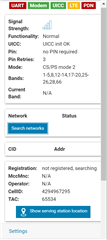I just received the Thingy 91 this morning. I've inserted the SIM have verified it on the nRF Connect for Cloud.
I cannot proceed to the next step, as the led continues to pulse blue - so I assume not connected to the network.
I am in the UK, South West London (SW15 6BF).
I assume there is no coverage here??
What are my options? If I need a different SIM, what am I looking for?
Thanks



